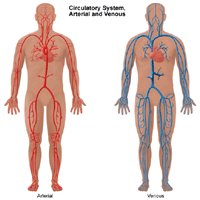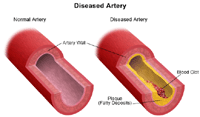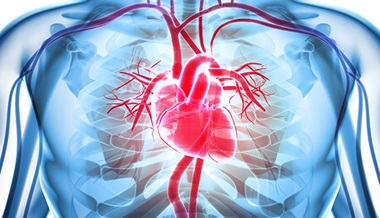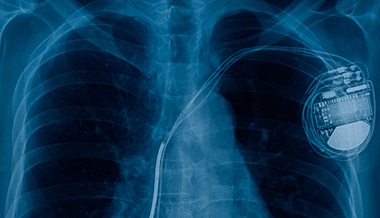Medical Management of Vascular Conditions
Vascular system overview
The blood vascular system is also called the circulatory system. It's made up of arteries, veins, and capillaries. Capillaries are tiny blood vessels between arteries and veins. They bring oxygen-rich blood to the body. The heart pumps blood through this network of blood vessels all over the body.
The blood vessels supply all of the body’s organs and tissues with:
-
Oxygen
-
Nutrients
-
Waste product removal
-
Fluid balance
-
Many other functions
Any diseases that affect the vessels may affect the organs supplied by those vessels. For example, a blockage in the heart’s coronary arteries may cause a heart attack.
What causes vascular diseases?
A vascular disease is a condition that affects the arteries or veins. Most often, vascular disease affects blood flow. This happens because the blood vessels become blocked or weakened. Or it happens because the valves in the veins get damaged. Organs and other body structures may be damaged by vascular disease if blood flow is decreased or fully blocked.
These 3 vascular diseases are among the main causes of illness and death in the U.S:
-
Heart attack (coronary artery disease)
-
Stroke (cerebrovascular disease)
-
Loss of limb or use of limb (peripheral arterial disease)
These 3 diseases can all be linked to the same cause: atherosclerosis. This is a buildup of plaque in the inner lining of an artery. Plaque is made up of fatty substances, cholesterol, cell waste products, calcium, and fibrin. These 3 vascular diseases are all linked to the same risk factors.
Atherosclerosis is a long-term (chronic) vascular disease that gets worse over time and affects the whole body. It affects the
-
The major blood supply to the brain (carotid arteries)
-
The blood supply to the heart (coronary arteries)
-
The peripheral arteries
How does atherosclerosis start?
Experts don’t know exactly how atherosclerosis begins or what causes it. It may start as early as childhood. But it can get worse quickly. With this disease, fatty deposits collect along the inner layer of the arteries. If it gets worse, plaque may form. This thickens and narrows the arteries. It can decrease or fully block blood flow to organs and other body tissues.
Having atherosclerosis in any one of these areas is a strong sign that you may have this disease in other parts of your body. Atherosclerosis in the arteries of the heart can cause a heart attack. Atherosclerosis of the arteries to the brain can cause a stroke. And atherosclerosis of the leg arteries can cause a blockage. A blockage can reduce blood flow. This can cause leg pain, or ulcers or wounds that don’t heal. Surgery to remove the foot or leg (amputation) may be needed.
It's important to manage your risk factors to help control vascular diseases caused by atherosclerosis. Studies have shown that making lifestyle changes can stop, and even reverse, the progression of atherosclerosis.
Vascular diseases may include more than one of the body's systems at a time. Because of this, many types of doctors treat vascular problems. Specialists in vascular medicine or surgery work closely with other doctors. These include doctors in internal medicine, interventional radiology, cardiology, and other specialties.
Who is at risk for vascular diseases?
A risk factor is anything that may increase your chance of having a disease. Different diseases have different risk factors. Risk factors that are linked with major vascular diseases are:
-
Diabetes
-
High levels of fats in the blood (hyperlipidemia), such as cholesterol and triglycerides
-
Smoking
-
High blood pressure
-
Obesity
-
Lack of exercise
-
Diet high in saturated fat
Although these factors increase your risk, they don't necessarily cause the disease. Some people with one or more risk factors never develop the disease. Other people have the disease and have no known risk factors. Knowing your risk factors for any disease can help guide you to take actions. This includes changing some habits and being checked for the disease.
How can risk factors be managed?
Medical care of vascular diseases most often includes managing certain risk factors, such as diabetes, smoking, high cholesterol, and high blood pressure. Here’s an overview of managing these 4 risk factors:
Diabetes
Diabetes alone, without the other risk factors, speeds up the rate of atherosclerosis.
High blood sugar (blood glucose) levels are linked to a greater risk of heart disease and stroke. Your blood glucose levels should be in the range of 70 mg/dL to 130 mg/dL before meals. A blood test called hemoglobin A1c can check if glucose levels have been controlled. This test averages your blood glucose levels over a few months. A hemoglobin A1c level of less than 7% is desired.
Hemoglobin is a substance found inside red blood cells. It carries oxygen to all the cells in the body. Hemoglobin can attach itself to glucose.
When too much glucose stays in your bloodstream for a long time, it will attach itself to the hemoglobin inside the red blood cells. The more glucose in the bloodstream, the more glucose will be attached to the hemoglobin. A hemoglobin A1c blood test will be able to show your average glucose level over 2 to 3 months. High hemoglobin A1c levels are linked to a higher risk for cardiovascular disease.
Your provider will figure out the best medicine and care for your condition. Diabetes may be managed with diet and exercise alone, or with medicines. These include oral medicines that lower blood sugar, or insulin.
High cholesterol
High cholesterol or hyperlipidemia is high levels of fats (lipids) in the blood. There are 2 main types of fats in the blood. They are cholesterol and triglycerides. Cholesterol is an essential part of all human cells. Triglycerides are needed to help move energy from food into body cells.
High levels of LDL (bad) cholesterol are one of the causes of changes to the inner layer of the artery's wall. High LDL levels are linked to plaque forming. This plaque becomes hard, blocking the artery and stopping blood flow.
Your cholesterol levels may rise and fall. This is based on the types of fat you eat, the amount of exercise you do, and your weight. Your healthcare provider may advise you to make changes in your diet. They may advise an exercise and weight-loss plan that’s right for you. In some cases, you may have a family history of high fat levels in the blood. Your provider will advise the best treatment for your needs.
Fat-lowering therapy may be advised to help reduce the progression of atherosclerosis. Your LDL level should be less than 130 mg/dL. But if you have a higher risk for heart disease, an LDL of below 100 is ideal. The best goal for your LDL cholesterol can depend on other risk factors. Your healthcare provider will consider your own risk factors to help figure out what is best for you. Healthy levels of other types of fats in the blood are:
-
Triglycerides lower than 150 mg/dL
-
HDL (good) cholesterol higher than 40 mg/dL
You may need medicine to stay at a healthy cholesterol level. And you may need to make diet and exercise changes. There are a few types of medicines used to decrease cholesterol. One type of medicine is statins. Studies have shown that some statins can:
-
Reduce the thickness of the carotid artery wall
-
Increase the size of the artery opening (lumen)
-
Reduce vascular inflammation (believed to be a cause of atherosclerosis)
Atherosclerosis may progress to the point of narrowing or blocking blood vessels. Another type of medicine may be used to prevent narrowing or blockage caused by blood clots. These medicines help prevent clots from forming inside blood vessels. These include aspirin and some prescription medicines.
Smoking
Smoking has been shown to help speed up the progression of atherosclerosis. It's one of the strongest risk factors for peripheral artery disease. Smoking is linked to lower rate of good results in vascular surgery, a higher amputation rate, and a higher number of heart attacks and strokes. Smoking is linked to a lower survival rate from heart attacks and strokes.
The effects of tobacco include:
-
Narrowing of blood vessels (as blood vessels become smaller, blood pressure is raised)
-
Increase in carbon monoxide levels in the bloodstream, which impairs oxygen transport
-
Blood clots
-
Atherosclerosis
-
Higher risk of blocked leg arteries (there is a 30% to 50% increase when you're smoking ½ a pack per day)
-
Heart attacks, strokes, or death
-
Worse surgery outcomes
-
Greater risk for amputation
Quitting smoking has been shown to decrease the progression of the atherosclerosis.
Current guidelines advise all smokers to quit. If you can’t quit smoking, your provider may refer you to a specialist. A specialist may advise:
-
Behavior change counseling
-
Support groups
-
Individual counseling
-
Learning new coping skills
-
Nicotine replacement therapy
-
Medicines
-
Follow-up care
Steps to stop smoking include the following:
-
Get rid of all cigarettes and ash trays before you quit.
-
Talk with family and friends for support.
-
Stay away from social events that make you want to smoke.
-
Ask your provider for a referral to a specialist to help you quit.
Most insurance plans cover medicines and services to help you quit smoking. In some states, Medicaid will include coverage for medicines.
Weight gain has been shown to be minimal after 1 year of not smoking. The benefits of quitting smoking outweigh the effects of weight gain.
High blood pressure
High blood pressure affects the structure of the artery wall. It makes atherosclerosis happen faster.
Blood pressure measurements are given as 2 numbers. Systolic blood pressure is the upper number. This is the pressure when the heart contracts. Diastolic blood pressure is the lower number. This is the pressure when the heart relaxes between beats.
Blood pressure is defined as normal, elevated, or stage 1 or stage 2 high blood pressure:
-
Normal blood pressure. This is systolic of less than 120 and diastolic of less than 80 (120/80)
-
Elevated blood pressure. This is systolic of 120 to 129 and diastolic less than 80
-
Stage 1 high blood pressure. This is systolic is 130 to 139 or diastolic between 80 to 89
-
Stage 2 high blood pressure. This is when systolic is 140 or higher or the diastolic is 90 or higher
These numbers should be used as a guide only. Having a single elevated blood pressure measurement is not necessarily a sign of a problem. Your provider will want to see multiple blood pressure measurements over a few days or weeks before making a diagnosis of high blood pressure and starting treatment.
Weight loss, regular exercise, and a healthy diet work well to lower high blood pressure. A weight loss of about 5% of your total body weight may lower your blood pressure. This can also help make blood pressure medicines work better. Getting 2½ hours each week of moderate aerobic physical activity can help lower your risk of high blood pressure. This includes things like brisk walking, pushing a lawn mower, ballroom dancing, or water aerobics.
Blood pressure medicines may be used to help control high blood pressure. Your provider will prescribe the right medicines for your needs. There are several types of medicines that act in different ways to lower blood pressure.






